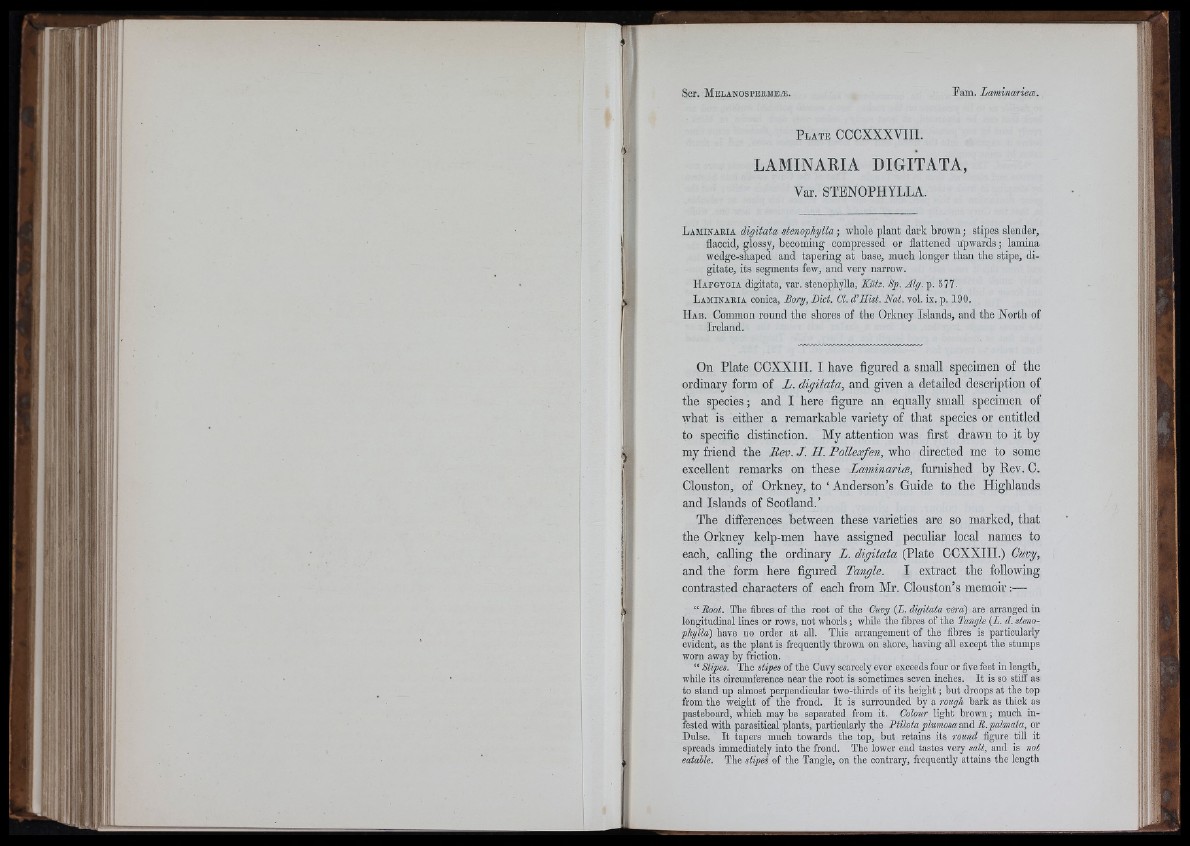
(i I lí
r ' í - í '
LAMINARIA DIGITATA,
Var. STENOPHYLLA.
L aminaeia digitata stenophylla ; whole plant dark brown ; stipes slender,
flaccid, glossy, becoming compressed or flattened upwards ; lamina
wedge-shaped and tapering at base, much longer than the stipe, digitate,
its segments few, and very narrow.
H afgygia digitata, var. stenophylla, KiiU. Sp. Alg. p. 577.
L aminaria conica, Bory, Diet. Cl. d’Hist. Nat. vol. ix. p. 190.
H ab. Common round the shores of the Orkney Islands, and the North of
Ireland.
On Plate CCXXIII. I have figured a small specimen of the
ordinary form of L . digitata, and given a detailed description of
the species; and I here figure an equally small specimen of
what is either a remarkable variety of that species or entitled
to specific distinction. My attention was first drawn to it by
my friend the Bev. J. H. PoUewfen, who directed me to some
excellent remarks on these Laminaria, furnished by Rev. 0.
Clouston, of Orkney, to ‘ Anderson’s Guide to the Highlands
and Islands of Scotland.’
The differences between these varieties are so marked, that
the Orkney kelp-men have assigned peculiar local names to
each, calling the ordinary L. digitata (Plate CCXXIII.) Cuvy,
and the form here figured Tangle. I extract the following
contrasted characters of each from Mr. Clouston’s memoir:—■
“ Root. The fibres of the root of the Cumj [L. digitata vera) are arranged in
longitudinal lines or rows, not whorls; while the fibres of the Tangle [L. d. stenophylla)
have no order at all. This arrangement of the fibres is particularly
evident, as the plant is frequently thrown on shore, having all except the stumps
worn away by friction.
“ Stipes. The stipes of the Cuvy scarcely ever exceeds four or five feet in length,
while its circmnference near the root is sometimes seven inches. I t is so stiff as
to stand up almost perpendicular two-thirds of its height; but droops at the top
from the weight of the frond. I t is surrounded by a rough bark as thick as
pasteboard, which may be separated from it. Colour light brown; much infested
with parasitical plants, particularly the Ptilota plumosa süA R .palmata, or
Dulse. I t tapers much towards the top, but retains its round figure till it
spreads immediately into the frond. The lower end tastes very salt, and is not
eatable. The stipes of the Tangle, on the contrary, frequently attains the length
'H
I ,1A|
■ Ii {‘1|
'4